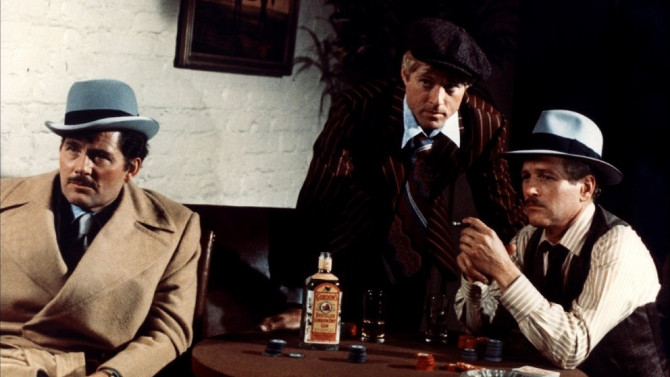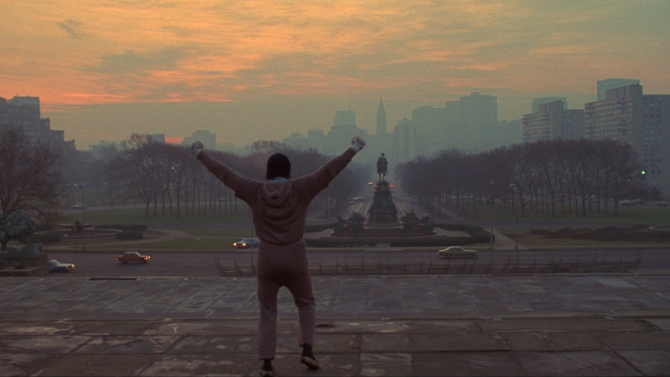
Safety First
Like a severe and utterly serious version of Stanley Kubrick’s 1964 satirical dark comedy Dr. Strangelove or: How I Learned to Stop Worrying and Love the Bomb, you would think that Fail Safe would have been the original release in theatres that was then later spoofed, yet that is not the case. Released approximately six months later in the same year, as you might imagine, it led to very poor returns at the box office – dare I say it (as the film deals with this subject matter)... it was a bomb! Despite that, over time, it has become a bonafide classic. Based upon Eugene Burdick’s 1962 novel of the same name and directed by Sidney Lumet (Dog Day Afternoon), he introduces us to our main players by way of little vignettes.
-
Star Pick with David Ebeltoft
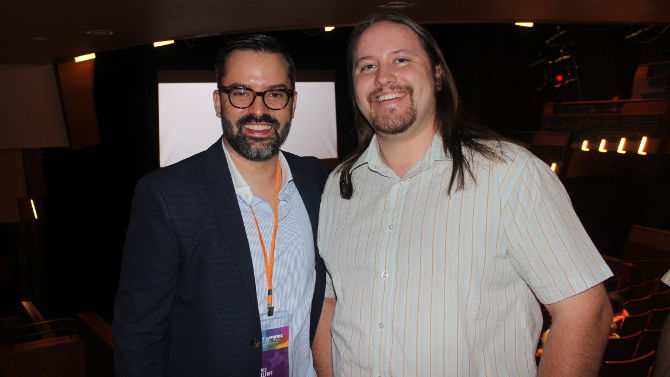 A Buzzworthy ProductionThe StingApril 18, 2017
A Buzzworthy ProductionThe StingApril 18, 2017Whether you’ve seen The Sting or not, it is nearly impossible not to recognize its main theme, titled "The Entertainer". A feel good, catchy, ragtime tune that is heard on and off from very beginning to utter end, it is Marvin Hamlisch’s reworking of the 1902 song by Scott Joplin that adds an auditory flair to the piece. It is this classic cinematic work that screenwriter David Ebeltoft, scribe of the Tribeca Audience Award Winner Here Alone, highlights as being his favourite. An up and coming writer in the business, his union with director Rod Blackhurst and producer Noah Lang (who was featured in last week’s Star Pick) seems like it is going to be a fruitful one, as the film making team have already announced two more features, You Were Once Called Queen City and North, following their first united effort – which has just been released and is doing very well in both theatres and online.
-
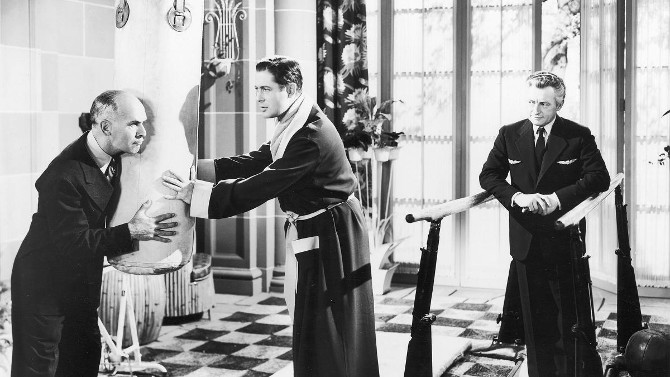
Air Jordan
Here Comes Mr. JordanApril 9, 2017There may be no film with a more influential pedigree that is lesser known than the fantastical 1941 romantic dramedy Here Comes Mr. Jordan. Honoured with a sort-of-sequel (1947's Down to Earth – starring Rita Hayworth, it also features reprisals from actors James Gleason and Edward Everett Horton. . . which itself inspired the 1980 feature Xanadu), it was also remade by Warren Beatty in 1978 – titled Heaven Can Wait. Chris Rock had a go with the subject matter in 2001 with his version, Down to Earth – reusing the title from the original sequel. In 1968, it was even remade in India – Jhuk Gaya Aasman – English translation: The Skies Have Bowed. At one point, even Bill Cosby tried to get a version of the story produced – though this iteration fell through. The intensely bitter and sweet tale of a boxer who gets in a plane crash, which is followed by a mistake in Heaven, it can also be seen as the precursor and inspiration for motion pictures like A Guy Named Joe (1943), It’s A Wonderful Life (1946), A Matter of Life or Death (1946), The Ghost and Mrs. Muir (1947), as well as so many others. Mashing together a multitude of genres which I will explain later, the boxer, Joe Pendleton (Robert Montgomery), who is soon to be competing for the world title, is gearing up for his next big bout. Trained by his loyal manager, Max Corkle (James Gleason), the two argue over the fact that he wants to fly himself to his next fight in New York City. Unable to convince the genial but stubborn athlete, it is soon after that he plummets to his ‘supposed’ death.
-
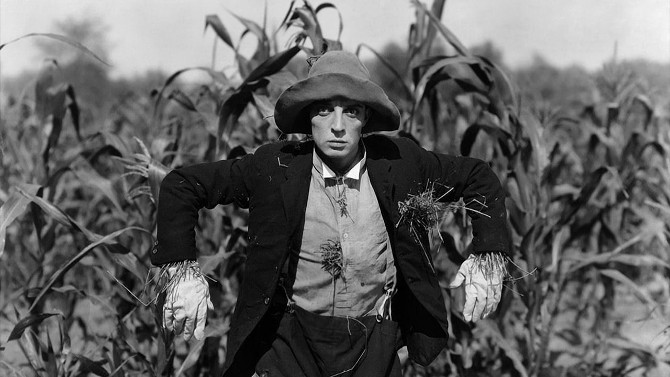
This Scarecrow has Quite the Brain
The ScarecrowApril 2, 2017I often wish the studio system would turn back time (in a sense) and begin to focus on developing short films again. A wonderful way to cultivate and produce young talents (think Charlie Chaplin or The Three Stooges), it also provides the audience with fun, brief excursions into fantastic worlds before even delving into the main feature. Comedy, drama, horror and even action work nicely in shortened versions, which is why I like to highlight certain pint-sized motion pictures from time to time – today, we will look at Buster Keaton’s 1920 comedy The Scarecrow. A premier example of ingenuity and the genius of motion, the nineteen minute tale follows two farmhands (diminutive Keaton and the much larger Joe Roberts – another example of the ever-comical combo of fatty and skinny) as they vie for the hand of the youthful and pretty farmer’s daughter (Sybil Seely). The two room together in a house of contraptions – the record player seconds as a stove, bed as a solid wooden piece of furniture/piano, bathtub as a settee and so on. Perhaps even more impressive is their dinner table design – ropes hang from the rafters on pulleys, meaning that everything from salt and pepper to food and beverages are attainable from anywhere at the table (Keaton had originally developed a similar mechanism at their family’s summer home when he was just a child). When done, they have a speedy way to do the dishes as well – afterwhich the ropes disappear and a light fixture descends from the ceiling. It is a spy’s house without the spy.
-
Star Pick with Doug MacLeod
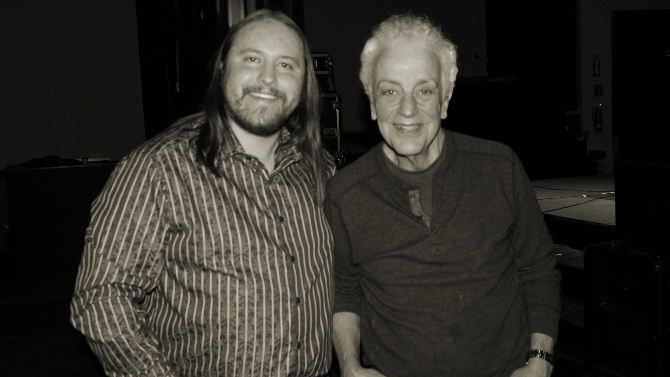 Beating the BluesRockyMarch 28, 2017
Beating the BluesRockyMarch 28, 2017Recently, I was fortunate enough to sit down with blues legend Doug MacLeod. A one man show, the acoustic maestro does it all while on stage; not only does he sing, play the guitar and stomp, but he also throws out important life lessons, tells jokes, and regales his audience with engaging stories – making him just as much a philosopher (see him live to learn of his bucket theory), storyteller, motivational speaker and stand-up comedian (though as the blues man quite cleverly pointed out, he is actually a sit-down comic – as he performs while seated). The winner of countless awards for his craft, the last few years should provide you with a good idea of his pedigree: in 2013, he took home Male Blues Artist of the Year at the Blues Blast Music Awards. Then in 2014, MacLeod won both Acoustic Artist and Acoustic Album of the Year at the Blues Music Awards, once again claiming the top prize of Acoustic Artist of the Year in 2016. This year, he has been honored with a nomination for his most recent album "Doug MacLeod – Live in Europe" – which is up for Best Historical Album, while also looking for a third win in the Acoustic Artist category. He has released an impressive 24 albums over the past thirty plus years.
-
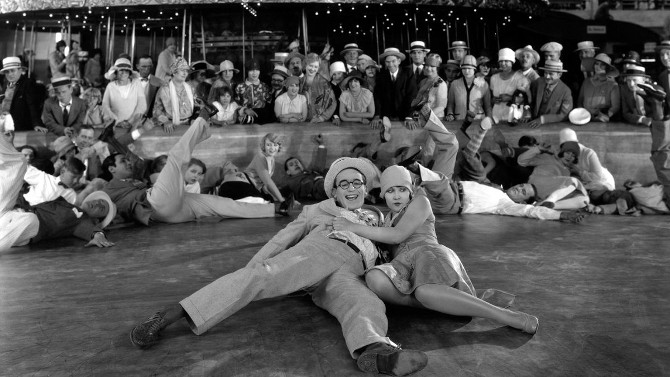
Need for Speedy
SpeedyMarch 12, 2017An unbelievable look back at 1920's New York City, Harold Lloyd’s final silent feature, 1928's Speedy, depicts The Big Apple in all of its hopeful Jazz Age glory. Featuring mind-boggling action and footage shot around the city, including old Yankee Stadium, down Broadway at beautiful Bowling Green, Coney Island in all of its former glory (Luna Park is on full display – it was ravaged by fire in 1944 and closed for good in 1946), Union Square in Manhattan, a ridiculous stunt in Washington Square Park as well as under the Brooklyn Bridge, and so many other places, it is a sweeping look at a city that has changed so very much over the ninety years since it was filmed there. The portion set near Sheridan Square in Greenwich Village (which is actually mostly an intricate set that Lloyd built in Hollywood), features a slower paced part of the city. With it having the last remaining horse-drawn streetcar route remaining, it highlights the final place in the metropolitan that has not been replaced by the hustle and bustle of the modern age. The streetcar owner is Pop Dillon (Bert Woodruff), whose granddaughter is Jane (Ann Christy), a young woman who is dating the job hunting Harold ‘Speedy’ Swift (Lloyd) – an ardent Yankees fan.
-

Not Your Everyday Mechanic
The MechanicMarch 5, 2017Alfred Hitchcock once said "if it’s a good movie, the sound could go off and the audience would still have a perfectly clear idea of what was going on". A perfect example of this is the first sixteen minutes of the 1972 action film The Mechanic. Directed by Michael Winner and starring Charles Bronson (the pair, who had made one film previously, would go on to make a total of six together), the plot follows an aging hit-man in Los Angeles. The opening sixteen minutes is a masterclass in patience, restraint and telling a visual story, without any dialogue. We watch as the man, named Arthur Bishop, intricately plans his next kill. No dialogue is needed to make this an effective scene, as it captures a tense atmosphere and places us in the mind set of our lead, as we now know that he has a deft touch at killing and is not to be messed with. It is a bold choice to open a movie and it is all the richer for it.

